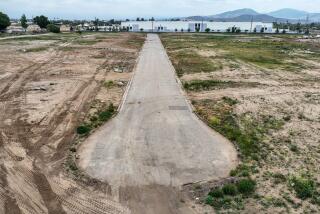Auditor Sees No Tax Hike Under Great Park Plan
- Share via
A by-the-numbers look at the so-called Great Park initiative shows it would not create any new taxes or tax increases, the Orange County auditor said Friday. But maintaining such a park at the former El Toro Marine base would cost the county $19 million over the next 18 years if it is approved by voters in March.
The report will be part of the ballot materials for the initiative, which seeks to replace airport zoning at the base with zoning for a large urban park, university and museum complex and sports park.
The report, which for the most part stayed neutral on the airport issue, was prepared by Public Financial Management, a national consulting firm with an office in Newport Beach. As part of its analysis, the firm also looked at the development of such large parks as New York City’s Central Park and Balboa Park in San Diego.
“We wanted the report to be a fair and objective analysis of the fiscal impacts stemming from the initiative,” said Auditor-Controller David E. Sundstrom, whose office commissioned the $187,000 report.
The analysis’ findings provide fodder for both supporters and opponents of a proposed airport.
The initiative’s biggest blow to county finances, the report said, would be the loss of a commercial airport at the base. An airport would create 84,714 jobs and generate about $6.2 billion in economic benefits to the county, the report states.
Conversely, a park and related development would create 2,955 jobs and $188 million in economic benefits to the county.
The analysis agrees with contentions by initiative supporters that the measure does not call for spending taxpayer funds to build a park; backers say it could be paid for with private money.
But, according to the analysis, county spending would increase about $19 million over that of an airport plan, or roughly $1 million a year, and would compete with other spending priorities. Most of the money would pay the costs of maintaining the base as is, except for development of some sports fields and an amphitheater, Sundstrom said.
“Where is the money going to come from? If it’s the general fund, well, what are we going to cut out? The sheriff’s budget? The health care budget?” said Board of Supervisors Chairwoman Cynthia P. Coad, who favors an airport at the base.
The analysis also noted that the initiative does not include the specific projects that Irvine city officials have proposed as part of their vision of a “Great Park.” That means those amenities would not necessarily be built as a result of the initiative’s passage.
If the land were annexed by Irvine, the report said, “neither the city nor the county would be required to comply with the initiative.” That point was echoed by David Ellis, a pro-airport spokesman: “Irvine is not bound by the initiative and people need to know this.
“What this fiscal analysis says is that if this initiative passes, it would put a padlock on El Toro and cost the county at least $1 million a year to keep the padlock lubricated,” Ellis said.
But El Toro airport opponents like Len Kranser disagreed.
“This report is great news for the initiative because it says no new taxes or increase in taxes is necessary to have a park there,” Kranser said, although he agrees that the measure doesn’t specifically provide funding to create the park.
The analysis also contradicted a study funded by a pro-airport group that said it would cost the county $418 million to buy the land. The auditor’s report said the land could be conveyed to the county for free because it is a public benefit.
In addition, the report said it is unlikely the initiative would result in more cleanup costs because the Navy must pay to clear the base of hazardous materials such as solvents used to degrease aircraft engines.
But the park initiative, if passed, would create a new issue for the Navy since the cleanup required for a park is much greater than that for an airport. And even if the land is turned over free of charge, it could be years before sections of the base were suitable for park use, according to Office of Economic Adjustment officials in San Francisco.
There is no guarantee the Department of Defense would turn the base over for free for a park, knowing that the cleanup costs would skyrocket. For example, the cleanup costs for McClellan Air Force Base in Northern California, a federal Superfund site, are estimated at $500 million over 34 years.
Under the report’s scenario, most of the proposed park is expected to remain undeveloped for at least seven years during the planning and design process. The first cultural facilities, including sports fields and an amphitheater on 200 acres, might not be developed for 18 years but are included with park maintenance for the $1-million annual price tag, Sundstrom said.
Kranser argued that if that sum is divided by the county’s 2.8 million residents, “it’s only 30 cents per person” a year to have the park.
Kranser also took exception to the report’s conservative estimates on revenue generated by the former base. There are 1,187 housing units, including two- and three-bedroom homes, Kranser said, yet the report based its estimate on only 300 homes at a monthly rental fee of $800.
Sundstrom said the consultant surveyed the homes at El Toro and concluded they would not serve as a large revenue generator.
More to Read
Sign up for Essential California
The most important California stories and recommendations in your inbox every morning.
You may occasionally receive promotional content from the Los Angeles Times.










